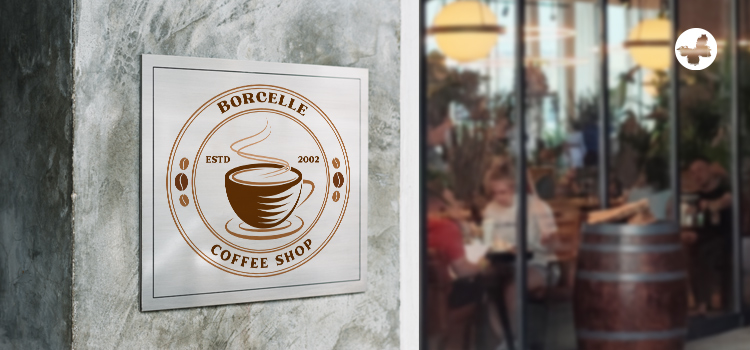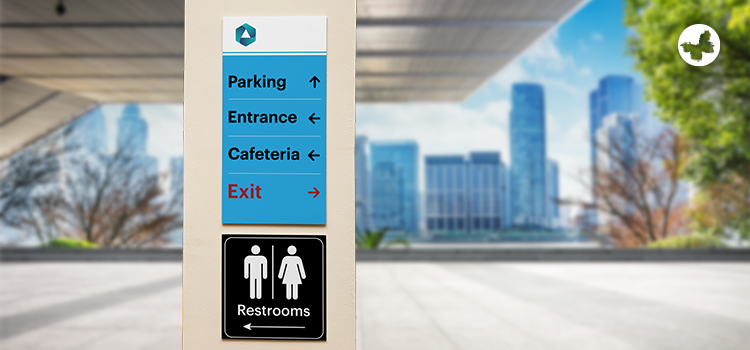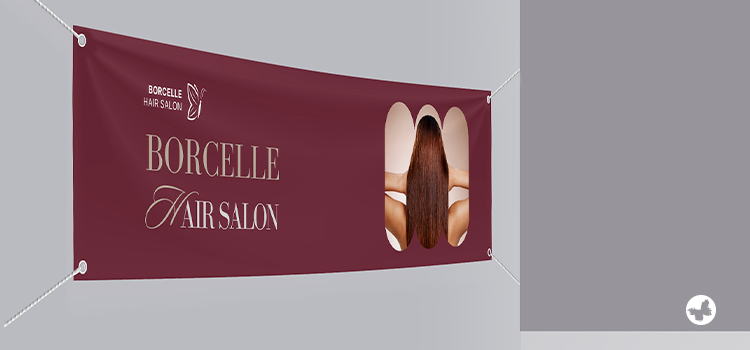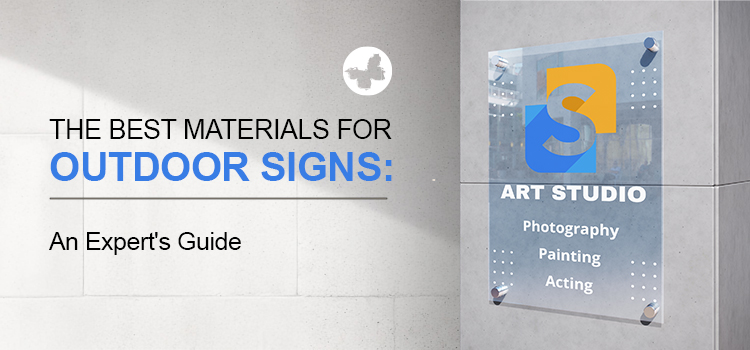The selection of outdoor sign material is essential to creating long-lasting signs that can withstand weather and endure over time. Outdoor print products include yard signs, flags, banners, and posters. Choosing the right materials can significantly contribute to the durability, utility, and visual appeal of the final product.
In this guide, we shed light on some high-performance materials well-suited for outdoor signs due to their strength, weather resistance, and striking visual impact.
Read More: The Most Effective Outdoor Signs to Boost Any Brand
Contents
Why Choose the Right Outdoor Sign Material?
Understanding the significance of selecting the best material for outdoor signs is integral to designing an effective signage campaign. The right material not only improves the lifespan of the sign but also enhances its visual appeal and ability to withstand environmental factors. This will guarantee that your outdoor sign serves its purpose for a long time. Two important benefits of the right material selection for outdoor signs include:
Visual Impact and Brand Representation
Your sign’s overall aesthetic appeal and polished appearance are directly impacted by the material selection. Various materials can communicate distinct brand messages. Wood can produce a rustic, natural feel, while brushed aluminium suggests a contemporary, luxury brand. The visual impact of your outdoor sign is increased by carefully selected content, which also draws clients and strengthens your brand identity.
Cost-Effectiveness
Higher-quality materials may cost more up front, but because of their durability and lower maintenance requirements, they frequently provide better value over time. Less expensive, less resilient materials might need to be replaced or repaired more frequently, which would increase the final cost over time.
Top Outdoor Sign Materials for Wholesale Printing
Your final choice for outdoor sign material depends on your budget priority and specific needs. Whether your need is for short-term promotional signage or long-term brand promotion, choosing the appropriate outdoor sign material can make a huge difference. In summary, the top 6 rigid materials for printing outdoor signs include
- Alupanel
- Acrylic
- Corrugated Plastic
- PVC
- Crezon Boards
- Aluminum
Alupanel Signs

Alupanel signage material increases the potency of aluminium with a polyethylene core. This trifecta breeds a lightweight, sturdy, and weather-enduring material that is a brilliant solution for outdoor signs. Furthermore, its main areas of use span outdoor establishments such as restaurants, retail outlets, and business parks.
Alupanel’s biggest strength is its immunity to dents and scratches, which ensures its longevity and visual appeal. Additionally, the smooth surface of Alupanel allows for high-resolution, detailed, and vibrant graphics.
Acrylic Signs
Acrylic, better known by its trade names Plexiglas or Perspex, is a clear plastic material. It wins the hearts of businesses for its durability, adaptability, and resistance to weather conditions. Moreover, acrylic offers a radiant, high-gloss finish that is reminiscent of glass at a fraction of its weight or cost. The resistance of acrylic signs to UV radiation adds to their longevity, maintaining colour and clarity in the long term.
High-quality outdoor signs often rely on either cast or extruded acrylic due to their excellent weather-resistant properties. This versatile material can be transformed into a myriad of shapes and sizes and can be efficiently lit from behind or on the sides, resulting in a visually arresting display.
Corrugated Plastic
Corrugated plastic, also recognized as Coroplast, offers an affordable, light, and weather-resistant option for temporary outdoor signage. If your requirement is short-term and the budget is tight, such as for yard signs, event promotions, and temporary outdoor displays, corrugated plastic stands as the reliable choice.
PVC Signs and Expanded PVC

Polyvinyl chloride (PVC) and expanded PVC are other excellent materials for outdoor signs. Lightweight, water-resistant, and highly resilient, both are suitable for long-term outdoor applications.
Moreover, PVC signs can deliver high-resolution prints with ease, with PVC offering a smooth surface and expanded PVC a slightly more textured one. Expanded PVC demonstrates flexibility, accepting curvatures and contours in the final design.
Crezon Boards Signs
Crezon is a popular signage material known for its outstanding resilience, weather resistance, and lightweight properties. Moreover, it has a flawless, smooth surface that allows for crisp, rich graphics, making this material especially valued for outdoor signage with high-definition image reproduction.
Essentially an outdoor-grade plywood, Crezon board signs are resistant to moisture and exhibit excellent dimensional stability, meaning they won’t warp or deform under different weather conditions. Furthermore, Crezon can be neatly cut into various shapes and sizes to meet precise design requirements, thus providing excellent versatility for a range of signage applications.
Aluminum Signs
Aluminium is a go-to selection for outdoor signs, and for good reasons—it’s adaptable, light, and notably resistant to weather conditions. Additionally, aluminium-based signage trumps rust, fading, and flaking, permitting the sign to maintain its visual allure and functionality over an extended duration. Aluminium is typically used in two forms: solid aluminium and Alumalite.
Solid aluminium sheets are typically 1/16th to 1/8th of an inch thick and offer excellent sturdiness and flatness, making them an excellent substrate for high-definition graphics and text. They’re also easy to cut into custom shapes and can be pre-drilled for straightforward mounting.
Read More: How to Choose the Perfect Material for Large-Format Signs: A Complete Guide
Factors to Consider When Selecting Your Outdoor Sign Material

When selecting a material for an outdoor sign, you should consider elements like wind, rain, sun exposure, and vandalism risk to make sure your sign is both functional and aesthetically pleasing for a long time. For the best results, keep the following factors in mind:
- Budget Requirements: Take your spending limit and the sign’s intended lifespan into account. Although some materials cost more, they are more durable and long-lasting.
- Durability and Weather Sign Resistance: Because outdoor signs are exposed to weather conditions, it is important to select materials that are resistant to wind, rain, snow, and ultraviolet light. Common materials include aluminium and some types of plastic.
- Vandalism Resistance: Materials with anti-graffiti coatings or less susceptibility to damage should be considered for signs in high-traffic or potentially vulnerable areas.
- Brand and Aesthetic Requirement: The content must be in line with your intended aesthetic and brand. Think about things like colour, texture, and the way your target audience will interpret the content.
- Installation and Maintenance Method: Take the material’s ease of installation and maintenance requirements into account. Sign materials differ in how easy they are to install and maintain. For instance, aluminium and PVC are typically easier to work with and offer low maintenance.
Conclusion
When making your choices for outdoor signage materials, bear in mind factors like projected longevity, desired visual impact, budget constraints, and environmental conditions, especially in Canada. Every material serves a variety of purposes, each with its own advantages and disadvantages. Therefore, choosing the right outdoor sign material ensures lasting, effective signage that aligns with your business goals.
ButterflyGP is an expert wholesale print partner with the best materials to guarantee the high quality of the final results for your outdoor signs. You can use the long-term experience of our professional team to ensure you choose the best outdoor sign materials.

It is a good title.
Thanks for sharing